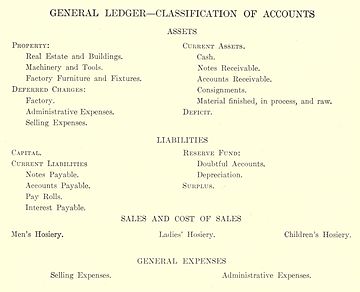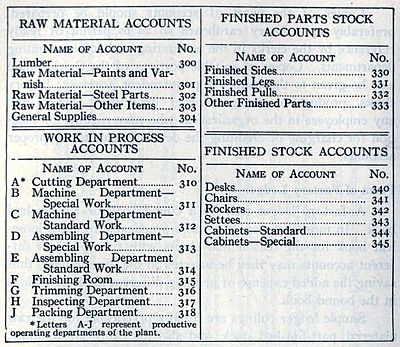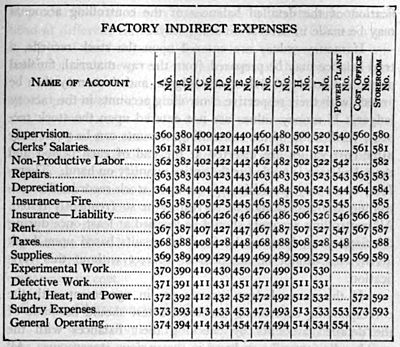|
J. Lee Nicholson Jerome Lee (J. Lee) Nicholson (1863 – November 2, 1924) was an American accountant, industrial consultant, author and educator[1] at the New York University and Columbia University,[2] known as pioneer in cost accounting. He is considered in the United States to be the "father of cost accounting."[3][4] Nicholson most important contributions to cost accounting consisted of "emphasizing cost centres and the measuring of profits for individual departments based on machine hour rates."[5] Also he helped establishing the National Association of Cost Accountants (NACA) in 1920, which resulted into the Institute of Management Accountants.[6] BiographyBorn in Trenton, New Jersey, Nicholson grew up in Pittsburgh, Pennsylvania.[4] After attending common school and business college, he started in industry. In his spare time he studied accountancy, and eventually in 1901 he obtained his Certified Public Accountant license for the State of New York.[7] Nicholson had started his career at the Keystone Bridge Company, where he worked his way up from office boy to assistant at the engineering department. In drawing up plans for the company foreman and superintendent, he started to develop his interest in cost accounting. At the age of 21, in 1884, he moved to the Pennsylvania Railroad Company where he had obtained an accounting position.[2] Around 1900 Nicholson started his own accountancy and consultancy firm J. Lee Nicholson and Company, specialized in cost systems for manufacturing organizations.[2] During World War I he served at the U. S. Ordnance Department as supervising cost accountant in 1917–18. He was promoted to the rank of Major,[8] and kept using his rank in public life, signed his work with Major J. Lee Nicholson, and is remembered by that name.[9][10] Previous to this position at the Ordnance Department, he was chief of the Division of Cost Accounting of the Department of Commerce. The filling of these positions gave him ample opportunity to become familiar with the war contract situation in its accounting aspects. In the summer of 1917 he was chairman of a conference of delegates from the War, Navy, and Commerce Departments, the Federal Trade Commission, and the Council of National Defense. This conference, in a pamphlet issued July 81, 1917, made certain recommendations regarding government contracts, and these recommendations are presented verbatim in Nicholson and Rohrbach's Cost Accounting (1919).[11]  Nicholson has been active in accountancy societies since the early 1900s. He joined the New York State Society of CPAs in 1902, where he became its first vice-president, and served as its president. In 1906 he also joined the American Association of Public Accountants. In 1920 Nicholson was founding president[12][13] of the National Association of Cost Accountants (NACA) founded in Buffalo, New York, the forerunner of the Institute of Management Accountants[14] Nicholson authored several books, including "Nicholson on Factory Organization and Costs" published in 1909, "Cost Accounting Theory and Practice" in 1913, and "Cost Accounting" in 1920 and several papers. All three books were published in multiple editions. Due to his ill-health he retired and moved to California in 1922, where two years later he died suddenly November 2, 1924 in San Francisco.[4][15] WorkEarly 20th century, when Nicholson started published his first work, the development towards modern cost accounting was well underway for two decades. Chatfield (2014) summarized that "After hundreds of years of painfully slow progress, cost accounting took off during the 1880s. Between 1885 and 1920, the essentials of modern cost technique were formulated and to some extent standardized in practice. Workable overhead allocation methods were devised, procedures were developed for integrating cost and financial accounts, and standard costing became routinized."[1] Chandra and Paperman (1976) specified, that "serious studies in cost accounting started only in the 1890s with the writings of Metcalfe, Garcke and Fells, Norton, Lewis, and later with Church, Nicholson and Clark. They were truly the pioneers who introduced new cost concepts like fixed and variable costs, standard cost, cost centers, relevant costs, etc. in the literature. The development of cost accounting in this period was undoubtedly slow. In addition, cost accounting tried to adapt itself within the framework of financial accounting. Part of the delay in the establishment of cost accounting concepts may be due to the tendency of cost accountants to keep the methods they had developed within their own firms secret."[16][17] Nicholson and Rohrbach (1919) specified that most work on cost accounting was written in the last decade, stating that "more than 90% of this literature has been published in the last decade, and fully 75% in the last five years."[18] More specific about Nicholson's role Chatfield (2014) noticed, that "Nicholson was less an innovator than a synthesizer. His main contribution was to organize, improve, and propagate this new knowledge as it spread from a tiny minority of pioneering firms to the vast majority of manufacturers who still had no formal cost accounting systems at the beginning of the twentieth century."[1] Nicholson in Factory Organization and Costs, 1909Purpose In 1909 Nicholson published his first book, entitled "Nicholson in Factory Organization and Costs". In the preview he explained, that this work was primarily intended as a handbook for manufacturers, who are interested in "modern methods of organization and systems"; for accountants and cost specialists as a book of reference; and also as a textbook on cost accounting for the student.[19] It was also Nicholson intention to outline and explain all the best known methods of Factory Organization, that relate to Cost Finding in such a manner as to enable the manufacturer to compare these methods with those in use in his own plant, in order that he may see more clearly the defects in his organization and how to remedy them. Nicholson hoped that the Public Accountant, Systematizer, and Cost Clerk would find this work to be of value as a reference in planning, devising, or changing a factory system.[19] ContentThe work contains forty-eight chapters. Among other important topics "Organization and Cost Finding" forms the subject of one chapter. In this chapter the author summarizes the most important arguments for and against cost systems; he also shows the effect of cost system on organization, independent of cost finding, pointing out clearly the value of system to management. The second important topic dealt with is " Wage Systems." Under this head the author points out the general relation of wage systems to costs, treating of the pay-rate-system, piece work and the differential rate plan, as well as profit-sharing and stock-distribution. The author then discusses the "Analysis of Cost Accounting", pointing out the fallacy of including selling and administrative expenses in factory costs; also criticisms of incorrect principles in distributing overhead charges. He then deals with the distribution of indirect expenses and explains the old machine rate, new machine rate, fixed machine rate, new pay rate, etc.[20] The fifth and sixth chapters constitute a general introduction to the subject of forms and systems and discuss such topics as principles used in forms and systems, estimated cost systems, actual cost systems, the designs and explanations relating to the conditions under which forms should be used.[20] Chapters seven to forty-two contain a large variety of forms (over 200). While undoubtedly a number of these forms or similar ones are to be found in ordinary treatises, nevertheless a good many, if not the majority of them, are original and have evidently been taken from actual experience. The author elucidates and fully explains the use of all the forms given and the advantages that can be derived from them. The forms are in large clear type and well arranged. And finally, the last chapters treat of mechanical office appliances. Analyses of cost accountingIn the third chapter Nicholson described, that in his days there was still a significant lack of knowledge on the subject of factory costs. Although the importance and desirability of accurate methods of ascertaining the cost of production is generally conceded, and while much attention has been devoted to this subject, and large sums of money expended annually in perfecting cost keeping records, there is a general lack of knowledge in many instances of the principles involved; and the problem now in hand is to present an analysis of the elements that go to make cost, and to indicate the lines along which methods must be devised to gather and classify the facts that are used in its actual determination. The accuracy and effectiveness with which this is done rests on, (1) the principles involved, and (2) the methods used.[21] Nicholson explained, that the elements that comprise the cost in all manufacturing enterprises are made up of three principal divisions:[21] 
The elements, that comprise the cost can be graphically depicted (see image). Beside the here three listed principal divisions, it mentions the selling and administrative expenses, together compromising the total expenses. Forms and systems for control of operationsThe biggest part of Nicholson in Factory Organization and Costs, is devoted the description of a control system of operations, which relies on a series of forms, and accompanying procedures. Nicholson explained:
The forms and designs were to be used in connection with the several systems in the Factory Organization. Nicholson introduced three of these systems in advance as follows: 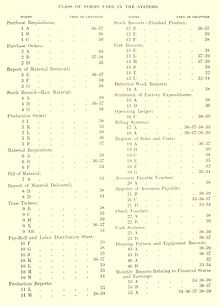
The whole series of forms presented in the work is summarized in a single sheet (see image). They are presented in 24 classes, covering operations from purchasing, material handling, stock keeping, time tickets, and production records, to cost records, further accounting operations, to drawing patterns and monthly reports. It showed building blocks of the information architecture. Classification of factory accountsAs mentioned in the introduction, Nicholson helped standardize cost accounting practice,"[1] and contributed to the introduction of standard costing.[16] A basic building block in this effort is the classification of the accounting practices and factory procedures and reporting. Nicholson kept developing these classifications in his 1909, 1913 and 1919 books. In his 1909 "Factory Organization and Costs" he introduced the classification of the general ledger and of the operating ledger: Classification of factory accounts and organization, 1909 Nicholson (1909) explained, that the first question to be considered in designing a system is the results to be obtained. If the system is to be a complete one, these results will ultimately be shown in the general accounts, which are usually contained in a General Ledger.[26]
 The accounts, however, must be so kept and arranged as to admit of showing proper results, either at the end of the year or monthly, according to the general plan of the system.[26] Additional to the classification of general and operating ledger, Nicholson gave a classification of operating departments (see image). Nicholson (1909) continued, that in the classification of accounts herein set forth, it will be observed that the assets appear under three principal classifications namely:[26]
Nicholson (1909) continued to explain the ins and out of Accounts Receivable, the Consignment Account, the Factory Account (inventory of raw material as well as finished stock and goods in process of manufacture), Liabilities, Current Liabilities, Sales, Cost of Sales, etc.[27] Office appliancesAbout the last sixty pages of his 1909 work, Nicholson devotes to a treatment of mechanical office appliances, giving illustrations of such appliances and explaining fully the use of each one.[20] Nicholson explained that the purpose of chapter was to present information to the manufacturer which may aid him in the organization of his office and in the handling of the immense detail connected with the majority of manufacturing plants. He argued, that "the clerk hire generally necessary in the office of a large plant acts as a dead weight on the profits, and any device which promises to lighten this burden on the cost of production is at least worth careful consideration."[28] Nicholson made clear, that the general purpose of mechanical office devices are to lessen the indirect expenses of a factory, and as such clearly within the scope of a book on Factory Costs. The use of these devices would bring four distinct advantages:[28] 
The presentation of these kind of office appliances was more common in management books in those days. Richard T. Dana (1876–1928) and Halbert Powers Gillette devoted a substantial part of their (1909) Construction Cost Keeping and Management to the description of numerous office appliances. ReceptionA 1909 review in the Journal of Accountancy judged, that the work was the "first American treatise on cost accounting proper, dealing with the subject from an accountant's point of view."[29] The review continues: "The author, though keeping to the front in his treatment of important accounting principles applicable to the subject, has nevertheless written the book in clear and untechnical language... While it may be questioned whether the author has been successful in preparing a text-book for students, he has undoubtedly accomplished his prime object, that of supplying the manufacturer with a thorough treatise on a subject in which he is vitally interested, and that of giving professional accountants and cost specialists a valuable reference work."[20] Taylor (1979) recalled, that this 1909 work was the first presentation of a "unified treatment of the estimated cost system." Four years later Nicholson published his second book, Cost Accounting Theory and Practice, which described the "same methods for determining inventories, cost estimates, and analysis of cost of sales but he varied his verification technique."[2] Cost Accounting Theory and Practice, 1913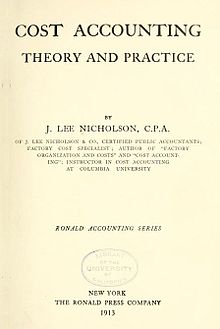 In 1913 Nicholson published Cost Accounting Theory and Practice. In this work he presented "the same methods for determining inventories, cost estimates, and analysis of cost of sales but he varied his verification technique. This book probably shows the results of his teaching experiences at New York and Columbia Universities. Mr. Nicholson also recommends, in this book, a method for estimating cost of sales at current prices which foreshadowed LIFO accounting."[2] Hein (1959) specified:
Newlove (1975) mentioned that this work was a very famous textbook, which "devoted four chapters to the allocation of burden costs to the special factory orders or to the product on its productive labor and machine (or process) methods; this emphasis greatly exceeded the space devoted to the collection, analysis and control of burden."[31] System of factory accounting In the late 1880s Garcke and Fells, had developed a system of factory accounting, and pictured its elements in four complementary flow diagrams. In 1896 J. Slater Lewis further developed this system, and pictured a diagram of manufacturing accounts, in which the four diagrams were integrated into one whole. A decennium later Alexander Hamilton Church (1908/10) would further develop this system by introducing the concept of production factors, and picturing the "Principles of Organization by Production Factors" around any organization. Using this concept of production factors Church was able to simplify the system of manufacturing accounts to a "Systems of Controlling Accounts." In the 1913 Cost accounting Nicholson & Rohrbach presented not one, but four different method of factory accounting:
In the same year Nicholson & Rohrbach published their work, in 1913/19, Edward P. Moxey published his influential textbook on accountancy, in which he also pictured the relation of stores records to commercial records. In his 1922 Cost accounts George Hillis Newlove further multiple similar Special Order Systems (see images).[36] Chart Showing Books under Special Order Cost System, 1922 Interest costsPrevits (1974) shared Nicholson among the foremost pioneers of interest costs, with William Morse Cole, John R. Wildman, DR Scott, D. C. Eggleston, Thomas H. Sanders and G. Charter Harrison. According to Previts "the early arguments over treatment of interest cost (both paid and imputed) spurred publication of countless articles and commentaries along with a relatively sound but since unheralded work Interest as a Cost..."[37] Nicholson explained his point of view in this matter in the 1913 article "Interest Should be Included as Part of the Cost" in the Journal of Accountancy in which he started the following argument:
Previts (1974) further explained, that the opposition consisted of a "politically more prominent group, and in the sense of the outcome, the success of their position may have been in large part because of such political strength. As early as 1911, Arthur Lowes Dickinson criticized advocates of interest inclusion. Dickinson's allies included R. H. Montgomery, Jos. F. Sterrett, and George O. May."[37] In the 1919 Cost Accounting Nicholson and Rohrbach again deal with the admittedly controversial question as to whether it is proper to treat normal interest return on passive investment as a part of manufacturing costs, the position is taken that interest on fixed assets should be so charged, but not interest on floating capital investment. The charging of some interest item is considered necessary to the successful distribution of overhead. Or, more exactly, normal return on passive investment is regarded as overhead to be distributed among the factory products. The authors in chapter IV considers that the opposition argument is directed chiefly at the practice of making these charges as part of the regular costs, not at the mere calculation thereof for use in statistical report form in the quotation of prices. He therefore suggests (page 140) an accounting procedure supposed to meet this objection.[11] The opposition view in that time was presented by William Andrew Paton and Russell Alger Stevenson in their Principles of Accounting (1919). To these writers, interest charges, whether contractual or non-contractual, are distribution-of-income, not expense, items. But, they say, if these charges are to be made at all, the logical procedure would be to distribute among the factory products the normal return on all the capital invested, not that on the fixed assets only. With this last contention, at least, the reviewer is inclined to agree. But Professors Paton and Stevenson appear to believe that the problem in hand is being solved on other than logical ground. For they say: "The use of interest charges in cost accounts on anything like a rational basis is a procedure which faces almost insurmountable practical obstacles. It is probably this fact rather than the logic of the case that is causing cost accountants to begin to recover from the interest obsession" [11][39] Uniform cost accountingNicholson has been recognized as a proponent of uniform cost accounting. According to Gerald Berk (1997) Nicholson was part of a group of "associationalists", which promoted the idea that "uniform cost accounting, not enforcement, was the best hope to channel competition away from cut throat pricing into product and manufacturing process improvement."[40] These proponents also assumed, that uniform cost accounting would increase factory efficiency. The general idea for manufacturers was, that "the more they would think systematically about 'planning, routing, and scheduling' conversion processes within the firm... the more they [would] understood about the cost of the many products they made, the more they could distinguish the profitable from the unprofitable."[40] In this context Nicholson had argued:
In their 1919 "Cost Accounting" Nicholson and Rohrbach expressed the idea, that "if the accuracy of the cost estimate has been tested and the sales price of the product has been properly determined on the basis of the tested cost estimates, then the proper profit margin of the product sold would be assured. The objectives of estimate-cost accounting... were to assure proper profit for the products sold and to test their manufacturing costs in detail."[42] National Association of Cost Accountants In 1919 Nicholson conceived and organized the National Association of Cost Accountants.[43] For a start he had initiated a special meeting of the American Institute of Accountants to talk about the subject of cost accounting in manufacturing industries. This meeting was held October 13, 1919 in Buffalo, New York, and let to the founding of the National Association of Cost Accountants (NACA), forerunner of the Institute of Management Accountants.[14] A total of 37 accountants attended the meeting, and among them were practitioners as William B. Castenholz, Stephen Gilman, Harry Dudley Greeley, and Clinton H. Scovell and professor of accounting Edward P. Moxey Jr. A total of 97 charter members joined in the initial organization, and among them were Arthur E. Andersen, Eric A. Camman, Frederick H. Hurdman, William M. Lybrand of Coopers & Lybrand, Robert Hiester Montgomery, C. Oliver Wellington, and John Raymond Wildman.[14] Nicholson was elected its first President 1919–1920. He was succeeded by William M. Lybrand. In the Presidents report in the first Year book of the National Association of Cost Accountants, Nicholson explained, that the Association had started with 88 Chartered members. In the first year an additional 2.000 applications for membership had been received.[44] Costs accounting, 1919State of the art of cost accounting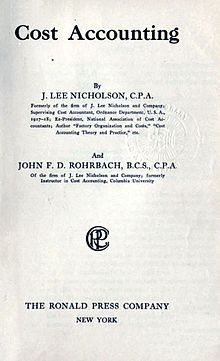 In the preface of the 1919 Cost Accounting Nicholson and Rohrbach gave their view on the state of the art of cost accounting in the United States.
One of the important aims of the book is to "classify the details of cost accounting so that the reader, be he accountant, manufacturer, or student, is given a well-defined idea of the forms and records required for each separate operation."[46] Content of Costs accounting, 1919Nicholson and Rohrbach's Cost Accounting is a revision and extension of Nicholson's "Cost Accounting, Theory and Practice", published in 1913, and represents a forward step in its particular field. There are seven distinct parts of the book, and the last preceding statement applies particularly to the first four parts, designated as follows:[11]
The following three parts are:
General Functions of Cost AccountingAccording to Nicholson (1920) it would be a mistake, to think that the scope of cost accounting is limited to finding costs only. The functions of a cost system are as follows:
About the relation of cost accounting and general accounting Nicholson (1920) proceeded:
And furthermore: "With the cost books once established, the best modem usage is to incorporate their record in total in the general financial books. In this way the modem cost system builds up an interlocking series of accounts which furnish the material for a detailed study of the operations of a manufacturing business."[47] Elements and Methods of Cost-FindingIn his 1909 "Factory Organization and Costs" Nicholson already presented a first analyses regarding the relation of the cost elements to selling price, which was visualized in a diagram (see above). In his 1919 work he explained that this analyses can be part of a "uniform methods of cost-finding." This means outlining the standard principles of cost accounting and, from these principles, arriving at uniform methods of treating costs as applied to a particular industry.[48] Nicholson explained that the greatest advantage to be derived from uniform cost methods is that of insuring a more uniform selling price. This object would be attained, even if the uniform system were not as scientific as it should be; for if errors were made through the method established, all manufacturers would at least be figuring the same way, all would be making the same mistakes, and unfair and ignorant competition would be eliminated.[48] Before determining the selling price of an article consideration must be given to the various elements of costs and expenses which have been classified as:[49]
The standard cost accounting system recognized not only expenses, but also different types of costs, and eventually the selling price:[49]
These gradations of cost may be further illustrated by means of the following simple diagram (diagram I), which illustrates the steps leading from the material cost to the selling price. This diagram is an extension of the analyses of cost accounting, Nicholson presented in 1909.[50] This type of visual analytics was presented earlier by Church (1901),[51] and became more common in introductory textbooks; see for example Webner (1911),[52] Kimball (1914),[53] Larson (1916),[54] and Newlove (1923).[55] Elements and Methods of Cost-Finding Nicholson continued, that in practice it is customary to allow certain deductions from the established selling prices, or from the established purchasing prices. These deductions can include trade discounts, allowances, rebates and/or cash discount.[49] As to the analysis of total of cost elements, every cost element can be traced back to certain kind of expenses, see diagram II. This kind of diagram was also more common in those days; see for example Dana & Gillette (1909),[56] Kimball (1914),[57] Kimball (1917);[58] and Eggleston & Robinson (1921).[59] Basic methods of cost-findingAs costs furnish the basis for determining the selling prices of the manufactured product, they naturally should be compiled so that the total cost of the job, order, or article may be readily ascertained. Actual conditions in manufacturing determine the system of cost-finding to be used, which should include :[60]
For present purposes the actual conditions which exist in manufacturing industries may be grouped or summarized in two general classes, and the methods of cost-finding applicable to these two classes may be designated as follows:[60] 
Form III shows in summarized form the two basic methods of cost-finding and the industries, or departments within a plant, to which they are applicable under the conditions already described. Factory Routine and Detailed ReportsBefore it can be decided which method of cost-finding may be used in any particular plant, the manufacturing departments of the plant must be classified. In some industries the order method of cost-finding might be applicable to certain departments, and the process method of cost-finding might be applicable to the remaining departments (see diagram IV).[61] In designing the system of "Factory Routine and Detailed Reports" first a classification is presented of factory departments and of factory orders. Diagram 4 shows the classification of various factory departments in summarized form.[62] Classification Chart of Factory Departments and orders Diagram V summarizes the various kinds of factory orders which may be issued and the functions of these records.[63] Furthermore, the system of "Factory Routine and Detailed Reports", proposed by Nicholson & Rohrbach (1919), incorporates three types of reports about the handling of material, labor and production: System of Factory Routine and Detailed Reports Diagram VI shows the various steps in the handling of material, and the material reports which are necessary to record material costs.[64] Diagram VII summarizes the various kinds of labor reports and the routine of reporting.[65] And diagram VIII summarizes the detailed items to be considered in the routine of production and the devising of production reports.[66] Distribution of Factory OverheadAt the turn of the 20th century, factory management was faced with the problem how overhead cost should be assigned to products, which lead to the modelling of costing systems. In the work of Nicholson the idea of cost centres was emphasizing, although he didn't coined or used the term itself. An accompanying problem was "how to distinguish between 'production' cost centres working directly for production and 'service provider' cost centres working for other centres... [to] cascade the distribution of the charges related to these cost centres."[67] According to Garner (1954) Nicholson in (1913) as well as to Webner (1917) and Taylor, where the first to tackle this problem.[67] Nicholson and Rohrbach (1919) further summarized, that the factory overhead that cannot be absorbed in the article cost directly is applied indirectly in the following manner:[68]
Nicholson continued explaining about different methods of distributing overhead. Assuming the departmental method of distributing overhead has been adopted, he said, there still remains the most complex problem of all – upon what basis shall the overhead be distributed within the departments so that each job, order, or article may be charged with the portion that properly belongs to it? In those days five methods were more or less standard, applied under definite conditions of manufacture. These are:[68] 
The items which make up the factory overhead and the methods of distributing them first to departments and then to product are summarized in diagram IX.[68] Compiling and Summarizing the Cost RecordsFurther classification of cost accounting details have been made as follows: Compiling and Summarizing the Cost Records Diagram X summarizes the information entered on different kinds of cost sheets and the method of posting and checking the data they contain,[69] and diagram XI shows in concrete form the cost summarizing records described all of Nicholson & Rohrbach (1919). The authors noted, that the distribution record, may be used for all summary purposes. The sheets of each summary may be classified in sections in a loose-leaf binder, each section being kept separate by means of tab indexes, thus providing a means for ready reference. The folios of each section should be numbered for posting purposes.[70] Controlling the Cost RecordsIn the chapter about "General Ledger Control of Factory Accounts", Nicholson & Rohrbach explained that in large manufacturing concerns it is customary to provide a chart or a classified list of accounts showing the exact name of each and the transactions to be recorded therein. Where the classification is elaborate, it is well to use account numbers or symbols so as to facilitate ready reference to them and thus save the bookkeepers' time. The authors advise, that such a chart should be printed upon heavy paper or cardboard and hung in view of those who have occasion to refer to it frequently. Where desks are equipped with glass tops and the chart is inserted under the glass, reference can be made to it very readily.[71] The requirements of each concern govern the number of copies of the chart of accounts to be prepared and the members of the staff to whom they are to be given. Ordinarily it is necessary for each clerk in the accounting and cost departments to have his own copy, while an additional copy should be given to the purchasing agent and treasurer or the officer who is in charge of the accounting records. Portions of the chart of accounts may be given to the plant superintendent, production manager, factory foreman, stock clerks, and factory clerks.[71] The chart shown in diagram XII gives a classified list of accounts of a large manufacturing concern. Last part of the system presented are the scheme's concerning the controlling the cost records:[71] Elements and Methods of Cost-Finding Diagram XIII summarizes the discussion of the factory ledger accounts.[72] For the same reason that it is advantageous to draw up a classification sheet of the general ledger accounts of a large manufacturing plant, the factory ledger accounts may also be illustrated by means of a chart (diagram XIV). In preparing such a chart, the accounts should be given symbol numbers. It may be noted that factory ledger controlling accounts vary in number from the three simple accounts previously described to several hundred.[73] Classification chart of Factory Ledger Accounts The arrangement of the accounts in the ledger should receive attention. While they are often arranged according to their symbol numbers, as their classification is more or less standardized according to Nicholson & Rohrbach (1919), they may be grouped in sections in the following order:
The sections should be distinguished by means of tab indexes marked according to the classifications. Where detailed overhead accounts are kept for each department, it may be well to furnish additional tab indexes within this section marked with the departments of the plant so that the overhead accounts of one department may be readily distinguished from those of another.[73] With these classification charts Nicholson & Rohrbach (1919) presented their idea's, which became known as the definition of cost centres.[67] ReceptionIn a 1919 review in The American Economic Review, Stanley E. Howard stated, that the materials of the volume are well organized. The reader is given a bird's eye view of the problems dealt with, and is then shown in detail the development of cost and controlling records from the various business and factory forms. The authors have taken pains to emphasize relationships, presenting frequent summary charts. Fundamentals regarding the forms for orders, reports, and records have been illustrated, and the mistake has not been made of confounding multiplicity of illustration with clarity of exposition.[11] The volume is intended for use by accountants, manufacturers, and students. Members of the first two groups, according to Howard (1919), would find particularly useful the information contained in the tables of approved depreciation rates for different types of assets, as well as the discussion of the relationship between Overtime and the modification of standard depreciation rates.[11] Howard (1919) ended his review by stating, that the issue is probably beclouded by reason of the different points of view involved. The cost accountant wishes, among other things, to furnish the selling department adequate data upon which to base a price policy. The general accountant has in mind the preparation of correct, unpadded statements of condition and of operation. For the purposes of the one certain information is needed, which by the other should be discarded. Reconciliation of the opposing ideas ought to be possible, perhaps along the lines suggested by Messrs. Nicholson and Rohrbach.[11] A second 1919 review by Arthur R. Burnet in the Publications of the American Statistical Association called the entire work a happy combination of theory and practical examples. Burnet found that the book is being used as a handbook in a number of organizations where cost systems were being installed or improved. The forms are illustrated and can be followed in actual practice. The chapter on the examination of the plant preparatory to the installation of a cost system, according to Burnet in those days, contained a valuable checking list which should furnish statisticians with a wealth of suggestions for the analysis of business.[74] A 1920 review, in the Financial World, more in particular mentioned, that "in the methods of manufacture, greater care must be exercised. The functions of a cost system are well stated by Major J. Lee Nicholson..." in his 1919 work.[75] Profitable Management, 1923Nicholson last book was Profitable Management, published in 1923. A 1923 review in The Annalist commented:
Hein (1959) further evaluated, that "modern writers on management theory and practice would have to examine it closely to find points not now being advocated in the current literature. It contains such recommendations as the costing of clerical and selling procedures, and the setting of standards as a means for comparison and control. Even today such procedures have not been widely adopted, although, since clerical costs are increasing at a faster rate than are factory costs, such control has much greater significance at the present time than it had in the early 1920s."[7] ReceptionNicholson reputation as cost accounting pioneer was acknowledged in his days. A 1920 article in The Packages, mentioned that "Major J. Lee Nicholson... reputation as a cost accountant and author extends from one end of the country to the other..."[77] Nicholson is further remembered as founder of the National Association of Cost Accountants.[15][78] In the Evolution of Cost Accounting to 1925 S. Paul Garner (1954) [79] described a number of important contributions by Nicholson. Hein (1959) summarized:
Hein (1959) further summarized:
According to Chatfield (2014) Nicholson's later writings "anticipated post-1920 developments in the use of cost figures for decision making and in the psychology of cost control."[1] He explained:
And furthermore Nicholson "refined and disseminated new knowledge about cost accounting, which had recently undergone revolutionary changes... As one of the earliest American cost accountants to teach the subject at the university level, he helped standardize practice and facilitate the interaction of ideas between academics and practitioners."[1] Selected publications
Articles, a selection:
References
Further reading
External linksWikimedia Commons has media related to Jerome Lee Nicholson.
|
Portal di Ensiklopedia Dunia
